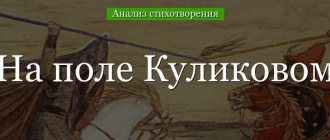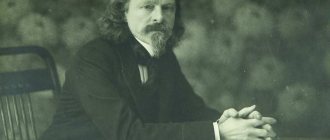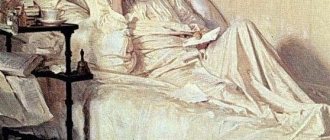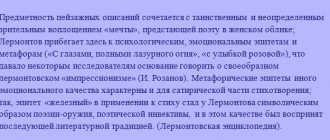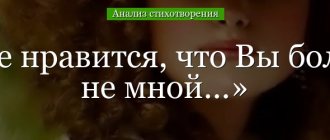Brief Analysis
Before reading this analysis, we recommend that you familiarize yourself with the poem I Enter Dark Temples.
History of creation - the exact date Blok wrote this poem is known: October 25, 1902. Then the poet was passionately in love with his future wife L. Mendeleeva.
The theme is the love of the lyrical hero, who is waiting for his chosen one to reveal her feminine essence.
Composition – the work can be divided into three parts. The first is the introduction, in which the hero either doubts that his beloved is the one who embodies eternal femininity, but still looks forward to meeting her. The second part develops philosophical thought, while emphasizing that the lyrical hero treats his beloved as an ordinary woman. The conclusion is the last stanza, in which he again brings the invisible essence of his lady to the fore.
Genre : lyric poem.
The poetic meter is dolnik.
Epithets - “dark temples”, “poor ritual”, “Beautiful Lady”, “illuminated image”, “Majestic Eternal Wife”, “tender candles”, “pleasant features”.
Metaphors - “the image looks”, “the Wife’s robe”, “smiles, fairy tales and dreams run”.
Analysis of A. Blok’s poem “I enter dark temples...”
The poem “I enter dark temples...” was written by Blok on October 25, 1902. This time was marked by important events in the poet’s personal life - falling in love with his future wife, L.D. Mendeleev. In addition, it is known that in the early period of his creativity Blok was interested in the philosophy of Vl. Solovyova. In the teachings of this philosopher, the poet was attracted by the idea of Eternal Femininity, or the Soul of the World. According to Solovyov, it is through love that the elimination of egoism and unity with each other is possible. “High love” for the world is revealed to a person through love for an earthly woman, in which one must be able to see her heavenly nature. All these thoughts and moods are reflected in the poem “I Enter Dark Temples...” In general, the mood of the work can be characterized as a mood of expectation. The lyrical hero is in love. He expects from his beloved the revelation of her feminine essence and, through this, the knowledge of Higher Femininity, Harmony, and merging with the world. Therefore, we can say that this poem is a combination of love lyrics with spiritual lyrics. The entire work is built on a metaphor. The hero enters the “dark temples”. I think this is a metaphor for love. The combination of these words is interesting; it reflects the hero’s attitude towards his feelings. “Temples” are something holy, divine, while “dark” is unknown, mysterious, alluringly mysterious and frightening. The hero does not know, doubts, his beloved is really She - the woman of his life, his destiny, his Goddess and Muse. Or is he wrong? But, despite this, he waits, trembling with excitement, because he loves: In the shadow of a high column, I tremble from the creaking of the doors. And looking into my face, illuminated, is only an image, only a dream about Her. What is important here, in my opinion, is the epithet “illuminated”, related to the image, dream, dream of Her. This image is illuminated by some kind of higher light, a premonition. The hero knows within herself that she is She. The further development of the poem confirms this: Oh, I am accustomed to these robes of the Majestic Eternal Wife! Smiles, fairy tales and dreams run high along the cornices. At first, the hero was uncomfortable with the thought that his beloved was the Majestic Eternal Wife, that is, the personification of the highest femininity, strength and weakness, harmony, which would save the world. But gradually he got used to the fact that every time he came into contact with such a miracle. Therefore, he says that he is “used to these vestments.” Now they don’t bother him, but inspire him to “smiles, fairy tales and dreams.” They inspire dreams of your beloved as an earthly woman. The last stanza completes the reflections of the lyrical hero. He brings to the fore the spiritual higher essence of his beloved. He “believes” that she is the embodiment of the Highest Harmony: Oh, Holy One, how tender the candles are, How pleasing are Your features! I can’t hear neither sighs nor speeches, But I believe: Darling - You. Thus, the poem can be divided into three parts: introduction, development of thoughts, conclusion. The language of the work is bright, rich in means of artistic expression. There are especially many epithets here (dark temples, a poor ritual, a Beautiful Lady, an illuminated image, the Majestic Eternal Wife, gentle candles, gratifying features) and metaphors (the image looks, the Wife’s vestments, smiles, fairy tales and dreams run). Syntactically, an inversion can be noted in the poem (I enter, I commit, I wait, etc.) This gives it measuredness and solemnity. There are exclamatory sentences here that convey the strength of the hero’s hopes and expectations. In general, the structure of sentences is quite simple. It corresponds to the “poor rite” performed by the hero. I believe that the poem “I enter dark temples...” is one of the best poems by A. Blok. It shows love, first of all, as a spiritual, emotional, emotional fusion of two people. In addition, I am close to the idea that only love will save every person and the whole world as a whole, because love is God.
Analysis of A. Blok’s poem “I enter dark temples...”
History of creation
In the early period of his work, Alexander Blok was very passionate about the philosophy of Vladimir Solovyov, and especially his teaching about eternal femininity. It made such a deep impression on the poet that one of his most famous poetic cycles - “Poems about a Beautiful Lady” - is based entirely on it.
The same philosophical thought is the basis of the poem “I Enter Dark Temples,” which Blok himself dated very precisely - October 25, 1902. At that time, the poet was passionately in love with Lyubov Mendeleeva, who later became his bride, and then his wife. He saw the girl as the embodiment of that same eternal femininity. Blok gave his love a mystical meaning, seeing a special feeling in it.
I enter the dark temples of the story of creation. Analysis of the poem I enter the dark temples of the block
For Alexander Blok, a woman was a creature endowed with divine power. Lyubov Dmitrievna Mendeleeva, the poet’s wife, became for him a kind of muse, a guardian angel and a Madonna who descended from heaven. But another break with the woman he loved inspired the creator to write the poem “I enter dark temples...”.
In 1902, Alexander Blok did not yet have the happiness of calling Lyubov Mendeleeva his wife. This was the period of his passionate love and interest in the ideology of V. Solovyov. The essence of this worldview was the exaltation of femininity and the divine essence of love for the weaker sex.
When Lyubov Dmitrievna broke up with the poet, it plunged him into deep sadness. Alexander Blok himself called this period of his life insanity, since he looked for his beloved in every woman passing by. The breakup made him more devout. The writer did not miss Sunday services and often visited churches in the hope of meeting Lyubov Mendeleeva. This is how the idea for the poem arose.
Subject
The main theme is love. The lyrical hero experiences passionate feelings for his chosen one, he sees in her his earthly goddess. Already in this work, the dual world inherent in all of Blok’s work is manifested: there is a world that can be seen and felt, and a second one that is unattainable, divine. This is the second theme of the poem - philosophical.
In general, it clearly reveals another feature of Blok’s early lyrics, when reality recedes before the illusory world. It is open only to the inner gaze of the poet himself and is invisible to no one else.
"I enter dark temples." The emotional atmosphere of the poem
The atmosphere of poetry hits the reader from the first lines. These are mysterious “dark temples”, rigor, asceticism with an admixture of anticipation and foreboding. “Trembling from the Creaking of Doors” betrays tension, high notes of anticipation contrasting with darkness and shadows. Red lamps add spice, it seems as if we are with the author and, just like him, we are waiting for his wondrous Lady.
The analysis of “I Enter Dark Temples” can be quite difficult and ambiguous. The symbolist Bloc never tells us what kind of temples he is talking about, but his task is not to tell, but to let us feel his poetry. In this poem his plan was a success. The feeling of anticipation merges with the mystical feeling of the presence of the image of the author’s beloved nearby. She is invisible, inaudible, but the poet knows that she will come to this dark temple, filled with shadows of doubt, and will easily dispel them.
Composition
Compositionally, the poem can be divided into three parts. In the first, the lyrical hero enters “dark temples” to perform his ritual. He has a little doubt that the woman he has chosen truly embodies eternal femininity, but he is in love, and therefore looks forward to his meeting with her.
The second part is the development of the main idea. The lyrical hero, no longer doubting, argues that he is given the opportunity to come into contact with a real deity every day. On the one hand, he understands that his beloved is the embodiment of everything divine that he cannot even imagine; on the other hand, he says that he is used to being in contact with a miracle every day, and this helps him think of his beloved not only as goddess, but also as a woman.
The work ends with Blok no longer emphasizing the earthly, but the sublime essence of his beloved. She embodies that lofty and beautiful thing that an ordinary person cannot comprehend.
About the creation of the work
The poem “I enter dark temples” was created on October 25, 1902. The constant author is Alexander Blok. The poet composed this work during the period when he was expecting to meet L. Mendeleeva, his future wife. In addition, at this time Blok begins to get carried away by the philosophical thoughts of Vladimir Solovyov. Solovyov said that you can get rid of egoism and experience the beauty of the world only by falling in love with a woman and finding the divine principle in her. Blok was very impressed by this idea.
The idea of Permanent Femininity became key in his work. These ideas and the expectation of a long-awaited meeting were the basis for the creation of the poem.
Means of expression
To emphasize his idea, Blok uses a variety of expressive means. Among them are:
- Epithets - “dark temples”, “poor ritual”, “Beautiful Lady”, “illuminated image”, “Majestic Eternal Wife”, “tender candles”, “pleasant features”.
- Metaphors - “the image looks”, “the Wife’s robe”, “smiles, fairy tales and dreams run”.
If you look at the syntactic structure of a sentence, you can see many inversions , for example, “I’m coming in,” “I’m waiting,” and the like. This makes it solemn and measured.
Means of artistic expression
Blok’s work “I Enter Dark Temples” is imbued with mysticism and symbolism. Just look at the epithet “dark temple”. After all, a temple is a symbol of something light, but by calling it dark, the author immerses the reader in a world of mysterious mystery. In addition, it is worth paying attention to other equally significant epithets: “poor ritual”, “pleasant features”, “tender candles”.
The author supplemented the general concept of the poem with successful metaphors: “smiles, fairy tales and dreams are running,” “an image is looking.” In the lines of the work, inversion is also noted, for example, “I enter,” which gives the whole poem a kind of solemnity. In turn, exclamatory sentences clearly emphasize how much the hero is waiting for his Permanent, Beautiful Lady.
The plot and composition of the elegy
In the first quatrain, the lyrical hero awaits the appearance of the Beautiful Lady, high love for her lives and does not find a way out, even when performing a “poor” ritual. Compared to the beloved, everything is colorless and small.
His impatient anticipation of the meeting is so great that the hero trembles even from the creaking of the doors. He does not see the image of the temple, but only her illuminated image.
The hero dressed his love in the solemn festive robes of the majestic and eternal Wife. He dreams: for him, smiles and fairy tales run along the cornices, which are located at a great height.
Meeting with love does not return him to the everyday world, but only raises him even higher above it. But this is not the end of the analysis of “I Enter Dark Temples...”. Blok sees nothing, and most importantly, he doesn’t want to see anything except pleasing features.
